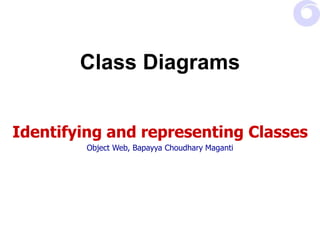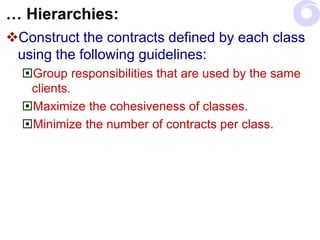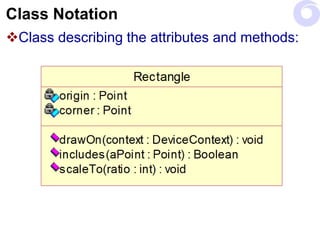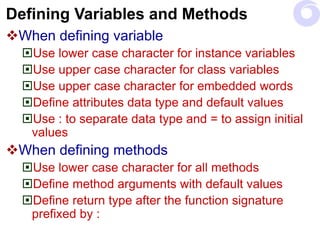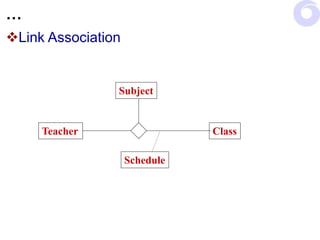07. Class Diagram.ppt
- 1. Class Diagrams Identifying and representing Classes Object Web, Bapayya Choudhary Maganti
- 2. How many classes Many Classes Classes have simple behavior Less encapsulation More reusable Easier to Implement Few Complex Classes More encapsulation, more private behavior. Less reusable Takes more time to implement More complex to implement
- 3. Design Consideration A class should have a single well focused purpose. A class should do one thing and perform it well.
- 5. Simple steps in finding a class Read and understand the specification. Extract noun phrases from the specification and build a list. Look for nouns that may be hidden (for example, by the use of the passive voice), and add them to the list. Applying the following guidelines: Model Physical Objects. Model Conceptual Entities. Use a Single term for each concept. Be wary of the use of adjectives.
- 6. … Classes: Identify the candidates for abstract super classes by grouping classes that share common attributes. Use packages to look for classes that may be missing.
- 7. Attributes & Operations Find responsibilities using the following guidelines: Recall the purpose of each class, as implied by its name and specified in the statement of purpose. Extract responsibilities from the specification by looking for actions and information. Identify responsibilities implied by the relationships between classes.
- 8. … Attributes & Operations Assign responsibilities to classes using the following guidelines: Evenly distributed system intelligence. State responsibility as generally as possible. Keep behavior with related information. Keep information about one thing in one place. Share responsibilities among related classes.
- 9. … Attributes & Operations Find additional responsibilities by looking for relationships between classes. is-kind-of Use is-kind-of relationships to find inheritance relationships. is-analogous-to Use is-analogous-to relationships to find missing superclasses. is-part-of Use is-part-of relationships to find other missing classes.
- 10. Relations Find the list collaborations by examining the responsibilities associated with classes. Ask: With whom does this class need to collaborate to fulfill its responsibilities? Who needs to make use of the responsibilities are defined for this class?
- 11. Relations Identify additional collaboration by looking for these relationships between classes. Is-part-of The is-part-of relationship. Has-knowledge-of The has-knowledge-of relationship and. Depends-upon The depends-upon relationships. Discard classes if no class collaborates with them, and they collaborate with no other class.
- 12. Hierarchies: Build Hierarchy graphs that illustrate the inheritance relationships between classes. Identify which classes are abstract and which are concrete. Draw Venn diagrams representing the responsibilities shared between classes.
- 13. … Hierarchies: Construct class hierarchies using the following guidelines: Model a kind-of hierarchy. Factor common responsibilities as high as possible. Make sure that abstract classes do not inherit from concrete classes. Eliminate classes that do not add functionality.
- 14. … Hierarchies: Construct the contracts defined by each class using the following guidelines: Group responsibilities that are used by the same clients. Maximize the cohesiveness of classes. Minimize the number of contracts per class.
- 15. Packages: Draw a complete collaboration graph of the system. Identify possible subsystems within you design. Name the subsystems. Look for frequent and complex collaborations. Classes in a subsystem should collaborate to support a small and strongly cohesive set of responsibilities. Class within a subsystem should be strong interdependent.
- 16. … Packages: Simplify the collaborations between and within subsystem. Minimize the number of. Collaborations a class has with other classes or subsystems. Classes and subsystems to which a subsystem delegates. Different contracts supported by a class or a subsystem.
- 17. Class Diagram Class Diagram with Class Name only Use Capital Start Character For Embedded Words start with upper case Make sure that the class name is descriptive Do not use abbreviations for class names A rectangle with class name represents the class notation. This is the basic notation for class name DrawingEditor
- 18. Class Notation Class describing the attributes and methods:
- 19. Defining Variables and Methods When defining variable Use lower case character for instance variables Use upper case character for class variables Use upper case character for embedded words Define attributes data type and default values Use : to separate data type and = to assign initial values When defining methods Use lower case character for all methods Define method arguments with default values Define return type after the function signature prefixed by :
- 20. Access Modifiers When defining the attributes and methods use following conventions - for private + for public # for protected $ for class (static) also by underlining the classifier / for derived An attribute whose value may be calculated based on the value of other attributes. Used to represent a value which is not persistence but used to hold a transient value (Performance vs. Memory)
- 21. Generalization Single Inheritance Tool is the super class Creation Tool and Selection Tool are subclasses Tool CreationTool SelectionTool
- 22. … Single Inheritance (Joint Notation) CreationTool LineCreationTool RectangleCreationTool EllipseCreationTool TextCreationTool
- 24. … Conjunction & Disjunction Car Ship CarShip Vehicle
- 25. … Complete & Incomplete Hierarchy Car Ship Vehicle …
- 27. Cardinality Association are: One to One One to Many Many to Many Many to One One to Optional Optional to Many One to Specified
- 28. Role – Significance on Link Mention Role on the assocation line beside the classes. Teacher Role: Teaches/Takes Attendence twords Student Role: Reports/Works-for twords Head Master Student Role: Lears/Answers Attendence twords Teacher Head Master Role: Instructs/Pays twords Teacher Brings the behaviour of classes Teacher HeadMaster Student
- 36. Dependencies vs. Associations Associations are structural Dependencies are non-structural Association is visible relations referred by global, static, local variable or obtained as parameter. Dependencies are transient links Have limited duration
- 38. Checkpoints Classes Clear Class names (Matches role) One well-defined abstraction (if not split) Functionally coupled attributes/behavior (look for proper cohesion) Generalization were made All class requirements were addressed Demands are consistent with state diagrams Complete class instance life cycle is described. The class has the required behavior
- 39. Checkpoints Operations Easily understood operations State description is correct Required behavior is offered Parameters are defined correctly Messages are completely assigned operations Implementation specifications are correct Signatures confirm the standards (target language) All operations are needed by use case realizations (Remove not required and duplicate)
- 40. Checkpoints Attributes A single concept Descriptive names All attributes are needed by use case realizations (Remove if not required or duplicate) Relationships Descriptive role names Multiplicities are correct
